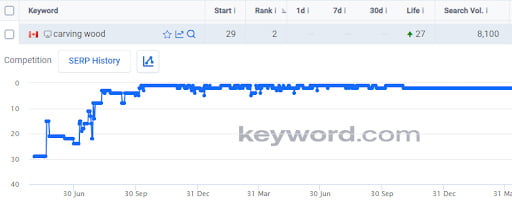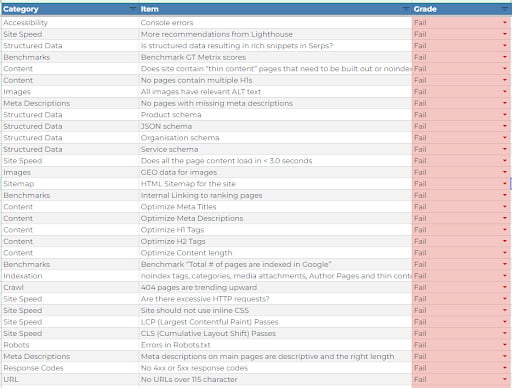Want to boost site traffic and sales for your ecommerce business? SEO is the way to go.
A Canadian woodworking and lumber business recently partnered with First Rank to improve its online presence and increase sales. It sells lumber and woodworking tools Canada-wide; the owners realized that they could boost online sales by improving its search engine rankings.
Why SEO Is Essential for E-Commerce Businesses
Our friends at Backlinko gathered together some incredible statistics on e-commerce SEO:
- 44% of people start their online shopping journey on Google
- 37.5% of all traffic to ecommerce sites comes from search engines
- 23.6% of ecommerce purchases are directly linked to organic traffic
Without ranking well on Google, ecommerce stores are leaving money on the table—money their competitors will be more than eager to scoop up. Someone needs to rank 1 for commercial keywords—it should be your business. The woodworking business we partnered with has certainly seen a massive difference.
Our Approach: Target High-Volume Keywords With Commercial Intent
Terms like “carving wood” and “live edge slabs” have a high probability of commercial intent—customers who search for these terms are looking to buy wood. They also have a high search volume.
Given the Canada-wide scope of the business, we decided that targeting these terms—along with a few local long-tail keywords for its home office—would be the best way to increase traffic and sales.
This strategy is quite different from the approach we would take for local SEO, where focusing on long-tail, hyper-local keywords is the best way to generate leads.
In local SEO, we would also focus on improving our client’s Google Business Profile—with ecommerce SEO, we focused entirely on high-volume commercial keywords.
Our Results: A Massive Increase in Traffic for Keywords With Commercial Intent
Over the course of a little less than two years with First Rank (20 months total), our ecommerce client saw:
- A massive 277.60% increase in sessions (visits to its website)
- A 149.48% increase in impressions (the number of times its website appeared in search results)
- A 49.98% increase in clicks (the number of times its URL was clicked from the search results page)
This increase was largely due to our strategy of targeting high-volume commercial keywords—keywords that tend to lead to higher conversion rates. We targeted keywords with search volumes in the thousands—here are some of our results:
Carving Wood
Started at position 29 and reached rank #1. From there, we maintained rank #2 for multiple months. This term has high commercial intent and 8100 searches/month.




Exotic Wood
Started at position 53 and reached rank #1. From there, we maintained rank #2 for multiple months. Again, this term has high commercial intent, with 5400 searches/month.
These results aren’t flukes—we dramatically increased this Canadian ecommerce company’s online profile, reaching rank #1 for a number of high-value, high-volume keywords:


Our Strategy: A Brief Guide to Ecommerce SEO
As you’ve seen from our results, ecommerce SEO can lead to dramatic online growth with the right strategies. Here’s what we did to ensure success for our woodworking ecommerce client:
Step 1: A Thorough Technical Analysis
The first step to any SEO strategy should be a thorough analysis of the technical and on-page factors that may affect the website. The accompanying image shows what our technical analysis of this Canadian ecommerce website revealed.
Lots of problems. There’s thin content, a lack of structured data (Schema), poor site speed, broken links, problems in the robots.txt, poorly optimized content, and a host of other challenges to be addressed. We also encountered several problems with Core Web Vitals—metrics Google uses to assess how user-friendly a website is.


Step 2: Technical Optimizations
Once we determined which improvements we could implement, we dove right in. We used several different strategies to:
- Dramatically improve site speed
- Optimize all images
- Ensure that all pages were properly indexed
- Fixed broken links, missing pages, and other crawl errors
With our technical work completed, we could begin to focus on improving existing content.
Step 3: Improving Product Pages and Existing Content
Ecommerce pages gain most of their traction through optimized product pages—these are the pages on which users can add products to their carts. Product pages contain both the bulk of an ecommerce site’s content and act as money pages—as such, they need to be optimized in ways that are quite different from local SEO.
Here are some of the steps we took to optimize the existing product pages:
- Added optimized meta descriptions to each product page
- Optimized headings for each page
- Added org and product schema
- Added rel=canonical tags where appropriate
The goal here was to ensure that it was easy to differentiate between product pages—both on the site and within Google’s search engine results pages.
Step 4: Adding Content to Product Pages and Building New Content
Using content gap tools, NLP tools, keyword research, and many other tools, we identified weak points in the site’s existing content. We shored up the content by:
- Adding FAQs to its product pages
- Adding thorough product descriptions and blurbs to its product pages
- Building evergreen blogs on general lumber and woodworking topics to attract clicks year-round
By focusing on developing content for each product page and focusing in particular on products with high monthly search volumes, we ensured that our technically optimized pages could now rank for the keywords we were targeting.
Step 5: Improving Off-page SEO
With high-quality, evergreen content in place, our outreach team developed a strategy to build a number of links from sites with excellent domain authority. We did this by:
- Finding high-quality linking opportunities with high-authority sites in the industry
- Building content on the site and encourage backlinks from it
- Crafting and sending high-quality outreach emails and follow-ups to prompt these sites to work with us
This strategy allowed us to earn several high-quality backlinks, helping us improve the site’s ranking.
Step 6: Adding Reviews and Schema
We continued our optimization by adding reviews to every product page, including schema, to ensure that those reviews could appear in Google Rich Results. Many of these product pages now have dozens of positive reviews; this has led to much higher conversion rates.
Work With First Rank for E-Commerce SEO
As you can see, ecommerce SEO can lead to stellar results. Our company takes a number of steps to ensure that we have the right strategy in place to generate more views, more clicks, and more conversions for your business.
We only take on ecommerce clients if we know we can help you grow your online presence to new heights.
The massive 277% improvement in sessions wasn’t a fluke—many of our clients see results like this.
You could be one of them. Partner with First Rank for ecommerce SEO today.


